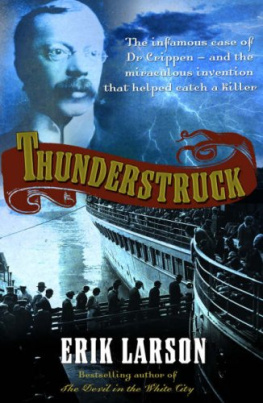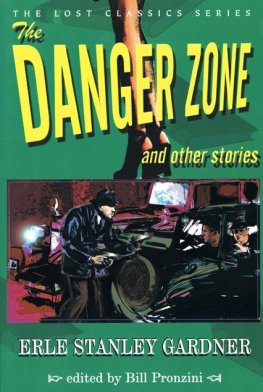T HERE IS MURDER IN THIS BOOK, the second most famous in England, but what I intend here is more than a saga of violence. P. D. James in The Murder Room has one of her characters observe, Murder, the unique crime, is a paradigm of its age. By chronicling the converging stories of a killer and an inventor, I hope to present a fresh portrait of the period 1900 to 1910, when Edward VII ruled the British Empire with a slightly pudgy cigar-stained hand, assuring his subjects that duty was important but so too was fun. It doesnt matter what you do, he said, so long as you dont frighten the horses.
The murder fascinated Raymond Chandler and so captivated Alfred Hitchcock that he worked elements into some of his movies, most notably Rear Window. Followed by millions of newspaper readers around the world, the great chase that ensued helped advance the evolution of a technology we today take utterly for granted. It was hot news indeed, wrote playwright and essayist J. B. Priestley, himself a scion of the Edwardian age, something was happening for the first time in world history. There was a poignancy as well, for the story unfolded during what many, looking back, would consider the last sunny time before World War I, or as Priestley put it, before the real wars came, before the fatal telegrams arrived at every great house.
This is a work of nonfiction. Anything appearing between quotation marks comes from a letter, memoir, or other written document. I relied heavily on investigative reports from Scotland Yard, many of which as best I can tell have not previously been published. I ask readers to forgive my passion for digression. If, for example, you learn more than you need to know about a certain piece of flesh, I apologize in advance, though I confess I make that apology only halfheartedly.
A safe but sometimes chilly way of recalling the past is to force open a crammed drawer. If you are searching for anything in particular you dont find it, but something falls out at the back that is often more interesting.
J. M. Barrie
Dedication
Peter Pan
1904
THE MYSTERIOUS PASSENGERS

O N W EDNESDAY , J ULY 20, 1910, as a light fog drifted along the River Scheldt, Capt. Henry George Kendall prepared his ship, the SS Montrose, for what should have been the most routine of voyages, from Antwerp direct to Quebec City, Canada. At eight-thirty in the morning the passengers began streaming aboard. He called them souls. The ships manifest showed 266 in all.
Captain Kendall had a strong jaw and a wide mouth that bent easily into a smile, a trait that made him popular among all passengers but especially women. He told good stories and laughed easily. He did not drink. By standards prevailing at the time, he was young to have command of his own ship, only thirty-five years old, but he was by no means untested. Already he had lived a life as eventful as any imagined by Joseph Conrad, whose novels always were popular among passengers once the Montrose entered the vast indigo plain of the Atlantic, though thrillers and detective tales and the latest books warning of a German invasion were in demand as well.
As an apprentice seaman, Kendall had served aboard a brutal vessel with a charming name, Iolanthe, where he witnessed the murder of a shipmate by an unstable crew member, who then began stalking Kendall to silence him. Kendall fled the ship and tried his hand at mining gold in Australia, a pursuit that left him penniless and hungry. He stowed away on another ship, but the captain caught him and marooned him on Thursday Island, in the Torres Strait off Queensland. After a brief stint harvesting pearls, Kendall joined a small Norwegian barkentinea three-masted sailing shipcarrying seagull excrement bound for farms in Europe, but storms tore away portions of its masts and turned the voyage into an epic of starvation and stench that lasted 195 days. His love of ships and the sea endured, however. He joined the crew of the Lake Champlain, a small steam-powered cargo ship owned by the Beaver Line of Canada but subsequently acquired by the Canadian Pacific Railway. He was its second officer in May 1901, when it became the first merchant vessel to be equipped with wireless. He caught the attention of his superiors and soon found himself first officer on the railways flagship liner, the Empress of Ireland. In 1907 he gained command of the Montrose.
It was not the most glamorous of ships, especially when compared to the Empress, which was new and nearly three times as large and infinitely more luxurious. The Montrose was launched in 1897 and in succeeding years ferried troops to the Boer War and cattle to England. It had one funnel, painted Canadian Pacifics trademark colorsbuff with a black topand flew the lines red-and-white-checkered house flag. It carried only two classes, second and third, the latter known more commonly as steerage, a term that originally denoted the belowdecks portion of a ship devoted to steering. A Canadian Pacific timetable from the era described the second-class quarters. The Cabin accommodation on the MONTROSE is situated amidship, where least motion is felt. The staterooms are large, light and airy. There is a comfortable ladies room and a smoking room, also a spacious promenade deck. An excellent table is provided. Surgeons and stewardesses are carried on all steamers. The lines motto was, A little better than the best.
The manifest for the upcoming voyage listed only 20 passengers in second class but 246 in third, nearly all immigrants. In addition the Montrose carried a crew of 107, among them a wireless operator, Llewellyn Jones. Canadian Pacific had been aggressive about installing wireless on its transoceanic vessels, and the Montrose, despite its age and modest decor, carried the latest apparatus.

T O BE SUCCESSFUL , K ENDALL knew, a captain needed more than skill at navigation and ship-handling. He had to dress well, be charming, and possess a knack for conversation, while also owning the mental wherewithal to monitor a thousand operational details, including whether the lifeboats were adequately secured, whether the correct foods and wines had come aboard, anda new responsibilitywhether the ships Marconi set and aerial were in good repair and ready to receive the inevitable flurry of trivial messages that engulfed a liner upon departure. Although the jokes, bon voyages, and riddles were utterly predictable, they nonetheless reflected the wonder with which people still treated this new and almost supernatural means of communication. First-time passengers often seemed mesmerized by the blue spark fired with each touch of the key and the crack of miniature thunder that followed, though shipping lines had learned from experience that wonderment faded quickly for passengers whose cabins were too close to the wireless room. They learned too that it was prudent to locate Marconi sets a good distance from the wheelhouse so as not to distort the magnetic field registered by the ships compass.
Before each voyage Kendall tried to read as many newspapers as he could to keep himself up to date on current events and thereby arm himself to meet his nightly obligation to host guests at his table. Amazing things were happening in the world, so there was a lot to talk about. A year earlier Louis Blriot had flown his airplane across the English Channel, from Calais to Dover. While on display at Selfridges department store, the craft drew 120,000 admirers. Science seemed foremost on peoples minds; talk of X-rays, radiation, vaccines, and so forth infused dinner conversation. If such talk ever lagged, there was always the compelling subject of Germany, which by the day seemed to grow more pompous and bellicose. Another foolproof way to inject life, if not violence, into a moribund conversation was to comment upon the apparent decline of morality, as made evident most shockingly in Bernard Shaws recent play, Misalliance, which Beatrice Webb, the social reformer, called brilliant but disgusting, with everyone wishing to have sexual intercourse with everyone else. If all the above failed to ignite a good conversation, one could always talk about ghosts. The whole country seemed engaged in the hunt for proof of an afterlife, with the exploits of the venerable Society for Psychical Research often in the news. And if by chance a conversation became too heated, too lively, one could recall anew how one felt upon the death of King Edward and remark upon how eerie it was that Halleys comet should appear at nearly the same time.












